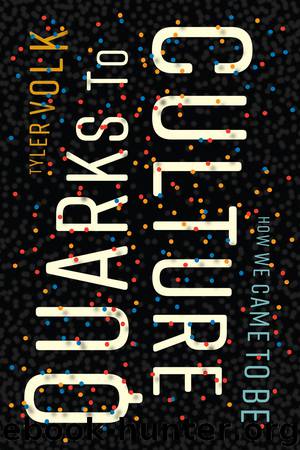Quarks to Culture by Tyler Volk

Author:Tyler Volk
Language: eng
Format: epub
Publisher: Columbia University Press
MULTIPLE ORIGINS OF AGRICULTURE AND THE COMING TOGETHER OF MULTIPLE SPECIES
Then came the origin of agriculture. I suggest that this event can be seen from a new angle using the lens of combogenesis.
In archaeologists’ parlance, the classical, umbrella term for this event is the Neolithic revolution. That term boldly points out this event’s transformational aspect in ancient prehistory, before writing. I believe the Neolithic revolution can be seen as a transition to a new level in the grand sequence from quarks to culture by combogenesis. How so?
Before getting into this event and its repercussions, I must note that although for simplicity I use the general term agriculture or agrovillage, I always mean to include animal husbandry. In fact, the first domesticated species, from wolf ancestors, was likely the woof-woof, the dog.6 In most places around the world, the domestication of plants and the domestication of animals were closely linked. The event of taming plants and the event of taming animals often took place in the same broad geographical region and roughly simultaneously (over, say, a few thousand years or less for a particular region).
What came together in this proposed event of combogenesis? Quite simply, plants and animals came to be controlled components or subsystems within the larger human metagroups’ cultural life-support systems. Humans learned to carefully tend and even worship these relatives from the earlier level of multicellularity. In such sites, there was gradually less and less going out and gathering, scavenging, or killing when hungry or raising the village en masse to labor for fish when the streams were flush with salmon. One could instead walk out, kill the fatted sheep, or dig into the common store of grain harvests that had been harvested from plants grown from seeds planted and tended the previous season.
How did this revolution happen? The details are buried and mostly lost in time. But archaeological digs have led to scenarios in which accidents at first led to increasingly more conscious incorporation of plants as the seasonal cycles of planting, tending, and harvesting occupied the tenders’ minds. Early on, having accidentally dropped seeds along walking paths on which they brought wild harvests back to their villages, people noticed new food-bearing plants along those paths or around their villages the next year. Today’s gardeners call these accidental plants “volunteers.”
Once conscious planting of seeds began, seeds that hung on more tenaciously in the grain clusters (heads) of the crops tended to be the seeds that made it to a processing station after harvest. So there was a serendipitous selection for seeds that clung on the heads until purposively shaken or beaten. This selection occurred in broadly similar ways with crops derived from wild grasses such as wheat, barley, millet, maize, and rice, despite differences in cultures around the world.7 Improvements also took place during the domestication of plants for edible tubers or fruits, such as potatoes and squashes in the Americas. All these events and more that were required for conscious agriculture were possible given human mental
Download
This site does not store any files on its server. We only index and link to content provided by other sites. Please contact the content providers to delete copyright contents if any and email us, we'll remove relevant links or contents immediately.
Sapiens: A Brief History of Humankind by Yuval Noah Harari(14216)
Sapiens by Yuval Noah Harari(5281)
Pale Blue Dot by Carl Sagan(4886)
Homo Deus: A Brief History of Tomorrow by Yuval Noah Harari(4801)
Livewired by David Eagleman(3663)
Origin Story: A Big History of Everything by David Christian(3632)
Brief Answers to the Big Questions by Stephen Hawking(3358)
Inferior by Angela Saini(3260)
Origin Story by David Christian(3133)
Signature in the Cell: DNA and the Evidence for Intelligent Design by Stephen C. Meyer(3055)
The Gene: An Intimate History by Siddhartha Mukherjee(3029)
The Evolution of Beauty by Richard O. Prum(2925)
Aliens by Jim Al-Khalili(2776)
How The Mind Works by Steven Pinker(2714)
A Short History of Nearly Everything by Bryson Bill(2616)
Sex at Dawn: The Prehistoric Origins of Modern Sexuality by Ryan Christopher(2472)
From Bacteria to Bach and Back by Daniel C. Dennett(2432)
Endless Forms Most Beautiful by Sean B. Carroll(2415)
Who We Are and How We Got Here by David Reich(2385)
